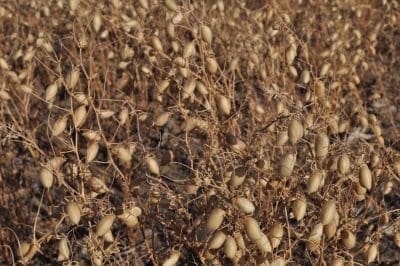CHICKPEA growers in Central Queensland are riding high as harvesters move through the first of this season’s crops, stripping yields as high as three tonnes/hectare.
Pulse Australia industry development manager for the northern region, Paul McIntosh, said the early sown crops, in particular, were looking extremely good.
“The yields in CQ have been outstanding. The lowest I have heard is two tonnes/hectare and the best is a solid three t/ha, which is fantastic,” he said.
There are 100,000 tonnes of chickpeas already booked out of the port of Mackay and the first loads have arrived there.
Mr McIntosh said further south on the Darling Downs, chickpea crops were in good shape and harvest was only about a week away.
But it is in the growing areas of NSW where weeks of wet weather and flooding have taken their toll on this season’s crops, causing water logging issues and wipeouts and cutting into earlier yield estimates.
Pulse Australia last week shaved the forecast for the national chickpea crop from a record 1.7 million tonnes to around 1.28mt, largely due to the big wet in the central and southern areas of eastern Australia.
The full extent of the waterlogging and fungal disease outbreaks is yet to be determined.
Pulse Australia chief executive officer, Nick Goddard, said it was difficult to say what the final outcome would be for this year’s crop because “it is a moving feast at the moment”.
“It is a story of two halves. In some places, pulses are looking really good in many areas like CQ, the Downs and certain places in NSW where the chickpea crops are on higher land where the runoff has been good,” he said.
“From Goondiwindi to Narrabri and the Liverpool Plains, west to Walgett and down to Warren on the flatter areas, it has been very wet and there have been significant losses and write offs. We have written off about half a million tonnes from that area.”
Disease pressure
Mr Goddard said of key concern was the fungal disease pressure the wet conditions had triggered, and the widespread shortage of fungicides to manage the threat.
“Pulse Australia has put in a lot of emergency use permits to try to bring in some new chemicals to help address that. But they are also running out,” he said.
“As we come down to the wire, the crops are starting to close their canopies and it is harder for the sprays to penetrate. So the disease impact is still unknown.
“It is unfortunate some growers have lost crops, but those who have nursed their crops all the way through with regular spraying are now in a position where they are doing their best to manage the disease before the crops start to dry off.”
Get our free daily cropping news straight to your inbox – Click here
Pulse Australia is also predicting a reduction in faba been production of up to 70 per cent in the hardest hit areas such as west of the Newell Highway in the Lachlan and Macquarie valleys which have experienced very heavy rain and run off in the past few weeks.
“The disease implications with faba beans is with chocolate spot which is now starting to take hold. It is manageable, but the issue is getting the chemicals to manage it. Again, there are more emergency use permits going through to try to address that,” Mr Goddard said.
Throughout Victoria and South Australia, Mr Goddard said before last week’s storm events the lentil crop was looking excellent, particularly in the Wimmera and Mallee of Victoria, and on the Eyre and York Peninsula of South Australia.
There had been earlier reports of lodging of faba beans, and the extent of lodging from last week’s wild weather was yet to be determined.
Frost impact
In Western Australia, severe frosts in recent weeks across the Great Southern were expected to impact the lupin crop.
Pulse Australia has prudently reduced yield estimates for lupins in WA by around 10pc.
The Grain Industry Association of Western Australia (GIWA) predicts lupin yields will be high in the Geraldton and Kwinana zones with excellent pod set apparent.
In the Albany and Esperance zones, large leafy crops and constant cloud have reduced pod set and were expected to reduce yield potential.
Pulse Australia 2016 fungicide guides for chickpea, faba bean and lentil crops: http://pulseaus.com.au/blog/post/2016-fungicide-guides





HAVE YOUR SAY